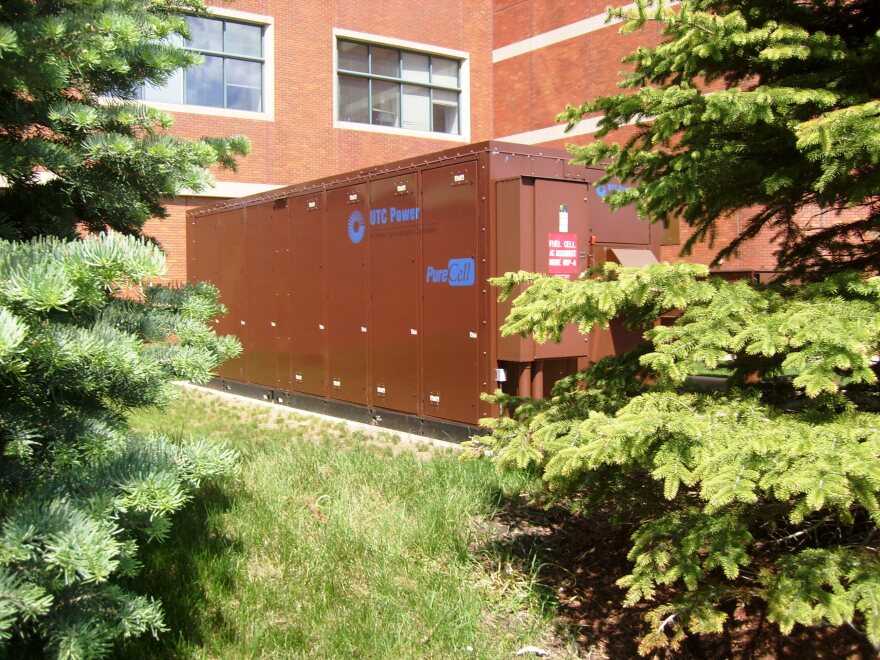According to a national study, the solar and wind industries account for 12,000 jobs in Wisconsin, including hundreds in Milwaukee.
Over 200 solar-related businesses are located in Wisconsin with noteworthy players in the green energy industry calling the southeastern part of the state home.
For instance, Johnson Controls is a worldwide leader in building efficiency. In Milwaukee’s Menomonee Valley, a cluster of firms makes equipment to harness the energy of wind and sun, including Helios Solar Works at 13th and Canal.
A robotic arm snatches rows of silicon wafers – they’re bright blue squares, the size of a credit card, and delicately positions them on a sheet of glass.
"We run two shifts and basically build to order," says John Kivlin, Helios' Chief Operating Officer.
Helios opened three years ago in Milwaukee’s valley and now employs about 30 people. The solar panels the team makes are converting the sun’s energy into electricity worldwide.
"We’ve got panels on a large project in the UK, we’ve got panels in Mexico. They’re residential, they’re commercial and utility scale," Kivlin says.
He admits the solar panel fabrication business is facing price pressure from China and describes the competition as intense, because the solar industry is growing so fast.
"Globally about 30 percent annually, and the U.S. is growing faster than that. I see it continuing to grow. I don’t think anybody believes fossil fuel is going to actually decline in price. The cost of solar is declining and I see it continuing to decline," Kivlin says.
As the industry grows, the benefits trickle to companies that provide parts. Helios’ suppliers include an Appleton firm that forms copper and a Milwaukee operation that employs visually impaired workers. They make aluminum frames for the solar panels.
About a mile west of Helios, the Italian company Caleffi has been making solar-powered water heaters since 2009. A stone’s throw away, Ingeteam is also banking, on the growth of green energy. The company opened here in 2011. It makes the devices solar panels need to convert the direct current they produce - DC, into alternating current - AC.
CEO Aitor Sotes says the Spanish firm chose Milwaukee from more than 100 potential locations in the U.S. partly because of its manufacturing heritage. He says Ingeteam employs 85 workers and is growing, as is the popularity of solar.
"We are hiring at a rate of two or three every week. Every Monday we have training sessions. So, we hope that by 2015 we will have 275 of us here," Sotes says.
In addition to solar, Ingeteam manufactures the “heart of wind turbines,” according to Jered Diebold. He’s sales manager.
"These are actually going up inside the cell of that wind turbine. Blades are actually turning the shaft of this generator. That’s where that electricity is actually produced, inside the machine," Diebold says.
Diebold bets more companies would move to wind or solar, if the U.S. maintained a stable energy policy and tax credits for investing in green systems.
A few local companies have become users. For example, Kohl’s has equipped nearly 140 of its stores –three in metro Milwaukee, with solar panels. The company says solar provides up to half the electricity they use.

In Racine, SC Johnson powers much of a manufacturing facility with two towering wind turbines.
Just to the north, Diversey utilizes another form of alternative energy – a fuel cell. The cell is a metal box about the size of a shipping container.
Fung Chin is the company’s manager of sustainable systems.
"A fuel cell converts natural gas into electricity and the capacity of this fuel cell provides enough power about 30 percent of the building. This reduces the carbon emissions an equivalent of about 680 cars annually," Chin says.

Inside Diversey, skylights flood offices with natural light. Sensors dim illumination when no one is present.
"The entire concept is to provide a higher performing building which will result in energy savings and a much better work environment," Chin says.
All the places we visited emphasize not only green technology, but conserving energy.
Gary Radloff is a researcher at the Wisconsin Energy Institute at the UW-Madison. He sees a bright future for renewables, and perhaps a “sea change.”
"You know right now our energy systems are very big, we have big powers plants etc. I think more energy’s going to be generated on site –at your business, at your home. I think storage is storage will occur on site. So it’s going to become a decentralized system. It’s going to be evolutionary –may not happen overnight, but it is definitely happening already," Radloff says.
Radloff calls it a “dramatic change” that will likely occur faster than people realize.


